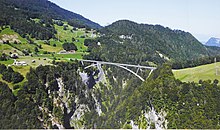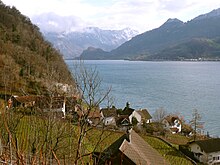Sarganserland constituency
| Sarganserland constituency | |
|---|---|
| Basic data | |
| Country: |
|
| Canton : |
|
| Main town : | Sargans |
| FSO number : | 1725 |
| Area : | 517.74 km² |
| Height range : | 419–3234 m above sea level M. |
| Residents: | 40,714 (December 31, 2018) |
| Population density : | 79 inhabitants per km² |
| map | |
The Sarganserland constituency is a sub-unit of the canton of St. Gallen in Switzerland , which was formed from January 1, 2003 according to the new cantonal constitution of June 10, 2001.
geography
The constituency is identical to the former Sargans district . It extends over the southernmost part of the canton of St. Gallen and thus includes a region that is also known under the name of St. Gallen Oberland .
politic and economy

The valley floor between Mels and Bad Ragaz is a popular residential area for commuters and land prices have risen sharply. Many work in Zurich , others in Werdenberg or in the Principality of Liechtenstein , but hardly any in St. Gallen . The A3 motorway and Intercity trains of the SBB provide easy access to the business capital of Switzerland .
The largest employer in the constituency itself is the health care industry with the Psychiatric Hospital Pfäfers , the rehabilitation clinics Valens and Walenstadtberg and the Hospital Walenstadt . Against the threatened closure of the Walenstadt hospital, the region is fighting energetically and emotionally as it used to for the construction of the Sargans canton school and the maintenance of the army facilities in Plons . However , it has become quiet about the wolves that have been living on Calanda since 2012 .
The Sarganserland does not have an actual center. Sargans is the seat of many regional institutions and is of historical importance, whereas Mels is more populous and the location of a large shopping center. The Grand Resort Bad Ragaz in Bad Ragaz ensures internationality and the Flumserberg winter sports area is important for tourism .
| Seats in the Cantonal Council (2020-2024) |
| Election year | 2004 | 2008 | 2012 | 2016 | 2020 |
| SP | 3 | 1 | 1 | 1 | 1 |
| glp | 1 | 1 | |||
| CVP | 5 | 3 | 3 | 2 | 3 |
| FDP | 2 | 1 | 1 | 2 | 2 |
| SVP | 4th | 4th | 3 | 4th | 4th |
| all in all | 14th | 9 | 9 | 10 | 10 |
The Sarganserland is considered down-to-earth and conservative. Between 2004 and 2016, the proportion of votes held by the Christian Democrats (CVP) in the Sarganserland constituency almost halved. By 2016 the share of the FDP increased slightly and almost approached the CVP. The SVP has been vacillating with around a third of the votes since 2004.
The Social Democrats (SP) have remained at around 15 percent since 2008. The Greens never really gained a foothold in the Sarganserland.
Political structure
The Sarganserland constituency comprises the following municipalities:
| coat of arms | Name of the parish | Population (December 31, 2018) |
Area in km² |
Inhabitant per km² |
|---|---|---|---|---|
| Bad Ragaz | 6102 | 25.40 | 240 | |
| Flums | 4858 | 75.15 | 65 | |
| Mels | 8623 | 139.11 | 62 | |
| Pfäfers | 1565 | 128.46 | 12 | |
| Fourths | 2937 | 61.76 | 48 | |
| Sargans | 6133 | 9.46 | 648 | |
| Vilters-Wangs | 4817 | 32.72 | 147 | |
| Walenstadt | 5679 | 45.68 | 124 | |
| Total (8) | 40,714 | 517.74 | 79 | |
history
The Sarganserland or St. Galler Oberland was a common rule in the Old Confederation from 1460 to 1798 and the southernmost district of the canton of St. Gallen from 1803 to 2002 . Since 2003, the region has formed an electoral district that includes the municipalities of Sargans , Vilters-Wangs , Bad Ragaz , Pfäfers , Mels , Flums , Walenstadt and Quarten .
Sargans County and the Old Confederation

The Sarganserland is a historically grown cultural region with its own identity. This was determined by the fact that it belonged to the former county of Sargans (13th – 15th centuries) and the federal bailiwick of Sargans as a common rule of the Swiss Confederation (15th – 18th centuries).
Part of the canton of St. Gallen
Already at the beginning of the Helvetic Republic the plans for a separate canton came to nothing. In 1803 the Sarganserland became the newly founded canton of St. Gallen . The Sarganserland is still an independent and politically and culturally strong canton region. The monastery Pfäfers was until repealed in 1838, church-religious and cultural center. The Sarganserland has belonged to the newly founded diocese of St. Gallen since 1847 .
Thanks to the extensive alpine areas , cattle breeding and trading were the main livelihoods of the population well into the 19th century . With the advent of the railroad - in 1858 the Chur – St. Margrethen , the Ziegelbrücke – Sargans line opened in 1859 - haulage and Walensee shipping lost their importance. The Sarganserland was an important mining region: until 1966, iron ore was mined at Gonzen . In the middle of the 19th century, the textile industry gained in importance. Nevertheless, the Sarganserland showed above-average emigration . From 1870, the bathing business in Bad Ragaz brought a tourist boom.
During the Second World War, the army established the Sargans fortress . The Sarganserländische Talgemeinschaft was founded in 1954 to protect the interests of the region. Thanks to their support, the Sargans Cantonal School was opened in 1963 . With the A3 and A13 motorways , traffic connections to Zurich and the canton capital St. Gallen have been improved. The storage facility of the Sarganserland power plants was built from 1971 to 1978 .
media
In Sarganserland there is the print medium Sarganserländer as well as Radio FM1, which emerged from Radio Ri .
literature
- Collection of Swiss Legal Sources, XIV. Department: The Legal Sources of the Canton of St. Gallen, Part Three: The Landscapes and Country Cities, Volume 2: The Legal Sources of the Sarganserland by Sibylle Malamud and Pascale Sutter, Basel 2013 online .
- Mathias Bugg: Sarganserland. In: Historical Lexicon of the Principality of Liechtenstein .
- Wolfgang Göldi: Sarganserland. In: Historical Lexicon of Switzerland .
- Werner Manz: Popular custom and popular belief of the Sarganserland (= writings of the Swiss Society for Folklore. 12). Basel 1916.
- Werner Manz: Contributions to the ethnography of the Sarganserland. In: Annual reports of the Geographical-Ethnographic Society in Zurich 13 (1912–1913), pp. 13–160 ( digitized version ).
Web links
- Wolfgang Göldi: Sarganserland. In: Historical Lexicon of Switzerland .
- Traces of the past in the Sarganserland .
- Lourdes grottoes in the Sarganserland .
Remarks
- ↑ Until 2008, the canton parliament had 180 instead of 120 seats since then.
Individual evidence
- ↑ Permanent and non-permanent resident population by year, canton, district, municipality, population type and gender (permanent resident population). In: bfs. admin.ch . Federal Statistical Office (FSO), August 31, 2019, accessed on December 22, 2019 .
- ^ A b c d e f g Regula Weik: Before the elections in the canton of St.Gallen: The militant transit country - a portrait of the constituency Sarganserland. In: St. Galler Tagblatt (online), March 5, 2020
- ↑ Saskia Bühler: Evening sales: disagreed in many places. In: St. Galler Tagblatt (online), June 20, 2018
- ↑ a b Cantonal election 2020: constituency Sarganserland. On the website of the Canton of St. Gallen, March 8, 2020
- ↑ Minutes of the election of the new cantonal council of March 14, 2004. On the website of the canton of St. Gallen, March 29, 2004
- ↑ Cantonal election 2008: constituency Sarganserland. On the website of the Canton of St. Gallen, June 18, 2019
- ↑ Cantonal election 2012: constituency Sarganserland. On the website of the Canton of St. Gallen, June 18, 2019
- ↑ Cantonal election 2016: constituency Sarganserland. On the website of the Canton of St. Gallen, June 13, 2019
- ↑ a b Thomas Oegerli: Cantonal elections in the canton of St. Gallen. Cantonal elections 2004 - 2016. In: Statistics currently 58 , Office for Statistics of the Canton of St. Gallen, February 2017 (PDF; 1.0 MB)
- ↑ Federal Statistical Office Generalized Limits 2020.
- ^ Wolfgang Göldi: Sarganserland in the Historical Lexicon of Switzerland

